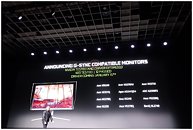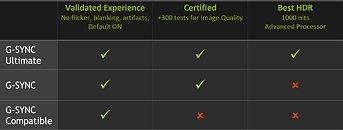Sunday, January 6th 2019

NVIDIA G-SYNC now Supports FreeSync/VESA Adaptive-Sync Technology
NVIDIA finally got around to realizing that the number of monitors with VESA adaptive-sync overwhelmingly outnumber those supporting NVIDIA G-Sync, and is going ahead with adding support for adaptive-sync monitors. This however, comes with a big rider. NVIDIA is not immediately going to unlock adaptive-sync to all monitors, just the ones it has tested and found to work "perfectly" with their hardware. NVIDIA announced that it has found a handful of the 550+ monitor models in the market that support adaptive-sync, and has enabled support to them. Over time, as it tests more monitors, support for these monitors will be added through GeForce driver updates, as a "certified" monitor.
At their CES event, the company provided a list of monitors that they already tested and that fulfill all requirements. G-Sync support for these models from Acer, ASUS, AOC, Agon and BenQ will be automatically enabled with a driver update on January 15th.
Update: We received word from NVIDIA that you can manually enable G-SYNC on all Adaptive-Sync monitors, even non-certified ones: "For gamers who have monitors that we have not yet tested, or that have failed validation, we'll give you an option to manually enable VRR, too."
Update 2: NVIDIA released these new Adaptive-Sync capable drivers, we tested G-SYNC on a FreeSync monitor.
At their CES event, the company provided a list of monitors that they already tested and that fulfill all requirements. G-Sync support for these models from Acer, ASUS, AOC, Agon and BenQ will be automatically enabled with a driver update on January 15th.
Update: We received word from NVIDIA that you can manually enable G-SYNC on all Adaptive-Sync monitors, even non-certified ones: "For gamers who have monitors that we have not yet tested, or that have failed validation, we'll give you an option to manually enable VRR, too."
Update 2: NVIDIA released these new Adaptive-Sync capable drivers, we tested G-SYNC on a FreeSync monitor.


231 Comments on NVIDIA G-SYNC now Supports FreeSync/VESA Adaptive-Sync Technology
AMD meant it when they called it FreeSync.
What I said was, even while explicitly saying its not about pointing fingers that Nvidia users are now in the ironical situation that they DO have full access to all variable refresh monitors while AMD users do not - and that even FreeSync was a lock-in no matter AMD's intent with their approach. The harsh, business reality is that AMD is now once again left with a less interesting proposition.
In terms of doing business you might have to wonder whether FreeSync was a smart move. A good one yes, I can only agree and I applaud them putting the 'consumer first' relative to Nvidia's move. But not a smart one from a business perspective. You are a smart man, surely you can see the paradox here. This company struggles to make profit, yet consistently drops the ball when it gets a chance to do so. Gsync was paid, nothing stopped AMD from making it a little bit less costly and still earn money on it. Money that could have gone to the R&D to actually keep playing in the GPU field, for example...
Its a pattern with AMD - good intentions with a touch of naive and lacking insight in how the market will respond to it, and what the bottom line will be as a result of that. Good intentions don't make you rich, unfortunately. Most consumers aren't brand loyal at all, but susceptible to marketing and 'good deals'.
en.wikipedia.org/wiki/Vendor_lock-in
In economics, vendor lock-in, also known as proprietary lock-in or customer lock-in, makes a customer dependent on a vendor for products and services, unable to use another vendor without substantial switching costs.
Let's see: AMD GPU needed FreeSync monitor. FreeSync monitor needed AMD GPU to use the tech... Nvidia GPU needed Gsync monitor. In both cases, switching brands while maintaining variable refresh would have incurred a 'substantial switching cost' - a cost higher than the cost of just a new GPU, or the cost of just a new monitor.
I mean... its not thát complicated is it.What? FreeSync is not even a nice to have for an Nvidia card user - up until today. They simply didn't care - or they paid for Gsync.
I can see why they rolled out without the 2nd gen module, it's more expensive and there probably aren't a lot on hand. But boy is it nice for the consumers that they can now buy the 144Hz 950F anyway if they have an NVIDIA card.
I have a FreeSync monitor and AMD GPU. Before this announcement, if I wanted to upgrade my GPU and keep using FreeSync I had to buy another AMD GPU thus locking me in to AMD products only.
And with an AMD Freesync setup, would you have bought an Nvidia card? Of course not, but now you can and lose nothing in the process.
Get it?
:shadedshu:
Prior to this announcement, the only way to get adaptive sync on NVIDIA hardware was by paying the GSYNC fee. Look at it this way (assuming NVIDIA card):
1) pay GSYNC fee to get adaptive sync support.
2) pay for a fixed sync monitor without adapative sync support.
3) pay roughly the same as #2 for a adaptive sync monitor but no GSYNC support.
#1 is vendor lock-in
#3 makes the most financial sense
AMD cards only ever had #2 and #3 as options.
Nonetheless I get what you are saying about the cost aspect wrt Freesync offerings and vendor lock in in a general sense.
Vendor lock-in requires a proprietary or customer component. VESA adapative sync is an open standard (for members) and AMD has open sourced their VESA adpative sync implementation (trademarked as FreeSync) through the GPUOpen initiative. You're accusing AMD of customer lock-in (NVIDIA proved they didn't with this announcement) when NVIDIA is provably guilty of both proprietary and customer lock-in.
Judging by the reply quoted above, yeah, I think you finally "get it." ;)
Researching this, I rediscovered NVIDIA's DP firmware update back in June...I wonder if it is related to this news:
www.techspot.com/news/74994-nvidia-releases-fix-displayport-issues-maxwell-pascal-graphics.html